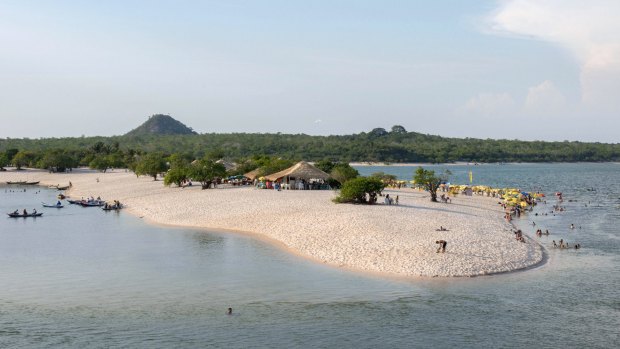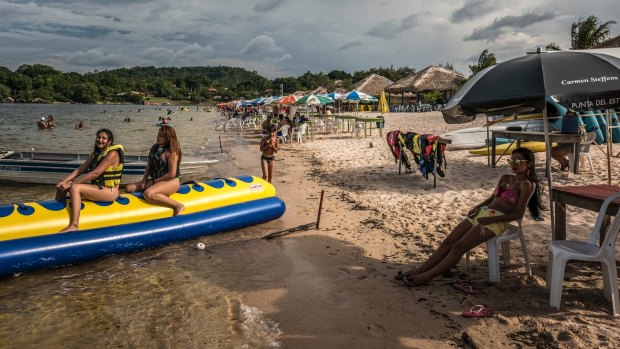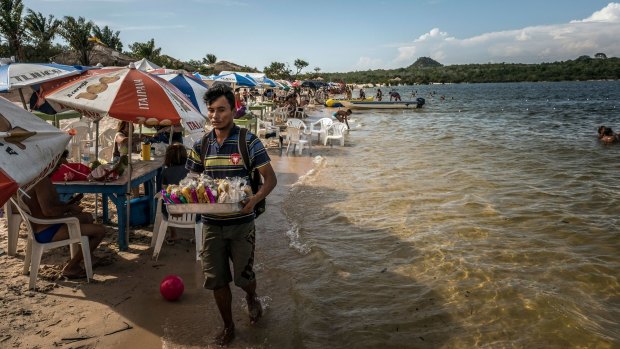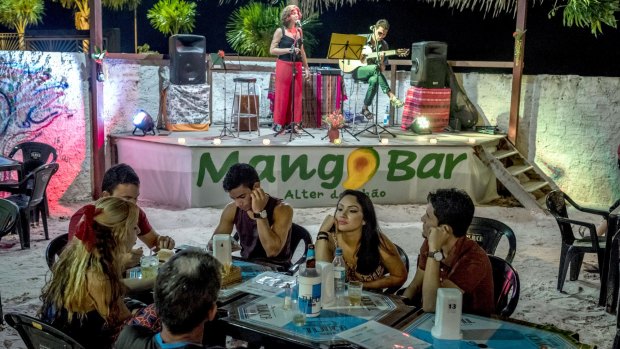This was published 7 years ago
Alter do Chao, Brazil: This white-sand beach town in the Amazon jungle is one of the world's most alluring
By Simon Romero

Alter do Chao Beach in the Island of Love in Rio Tapajos, Brazil.Credit: Alamy
Even though it is far removed from the sea in a remote corner of the Amazon jungle, Alter do Chão must rank among the world's most alluring beach towns.
White-sand beaches along the Tapajós River beckon visitors who drive from as far as Cuiabá, a landlocked city nearly 1609 kilometres to the south. The clear, warm waters lure snorkellers and practitioners of standup paddle boarding.
Just want to chill? Sit in a cafe, sip an ice-cold bottle of Tijuca beer and gaze at the sun setting over forest-shrouded ridges teeming with wildlife like sloths and howler monkeys.

Beachgoers relax and enjoy the amenities along the Tapajos River in Alter Do Chao.Credit: New York Times
While on a reporting trip this year in the Amazon Basin, I escaped to Alter do Chão for a few days after hearing tales of its rugged beauty. In a country with more than 7403 kilometres of coastline, I wondered if one of Brazil's best beaches could really be situated deep in the untamed interior of the world's largest rain forest.
"If you want to experience the real Alter, you'll have to eat the ants," Pitó, 55, a Cumaruara Indian who guides visitors on treks through the jungle, explained to me. He plucked a saúva ant out of the jungle floor and dared me to eat it. Crunchy like popcorn, it was delicious, with hints of lemongrass.
See also: TripAdvisor names world's best beaches for 2017

Even though it is far removed from the sea in a remote corner of the Amazon jungle, Alter do Chao must rank among the world's most alluring beach towns.Credit: New York Times
I couldn't have asked for a better guide than Pitó, whose full name is Raimundo Gilmar Faria da Costa. In the space of a few hours, he showed me how to hunt with a bow, navigate a canoe, fish with a harpoon, tap a rubber tree — even speak a few words of Nheengatú, the indigenous lingua franca that has persisted for centuries around the Amazon.
"I'll bet you don't get this stuff in Ipanema," Pitó said, joking about the legendary beach in Rio de Janeiro, the coastal city where I've lived for six years.
Of course, Pitó was right. For a singular Brazilian beach experience, one must travel all the way to Alter, which feels like a slow-paced oasis of tranquillity in a country on edge over a protracted economic crisis, colossal corruption scandals and rising political polarisation.

Musicians at Mango Bar, where patrons can enjoy drinks made with local fruits, in Alter Do Chao.Credit: New York Times
Alter wasn't always viewed as a rain forest beach town. Pedro Teixeira, a Portuguese explorer who led expeditions into the Amazon with the aim of enslaving indigenous peoples, established a colonial outpost here in 1626.
But for centuries, Alter remained a backwater, save for luring residents from the nearby city of Santarém and the occasional adventurer.
"The houses in the village swarmed with vermin; bats in the thatch; fire ants (formiga de fogo) under the floors; cockroaches and spiders on the walls," he wrote.
Despite such misgivings, this place grew on Bates, who would let his mind wander on Alter's beaches after conducting research in the surrounding forest into animal mimicry that supported Charles Darwin's theory of evolution.
See: Why Whitehaven beach is still a mystery to scientists
"The soft pale light," Bates wrote in The Naturalist on the River Amazons, "resting on broad sandy beaches and palm-thatched huts, reproduced the effect of a midwinter scene in the cold north when a coating of snow lies on the landscape."
Winter wasn't the first thing that popped into my mind when I explored sun-drenched Alter on foot.
In the heat, people wore the same beach fashions, from bikinis to boardshorts, that prevailed in Rio. The leafy plaza had a mellow vibe with vendors offering bowls of the deep-purple açaí fruit sprinkled with tapioca. In cafes, visitors savoured plates of Amazonian fish like pirarucu and tucunaré.
"This place is peaceful and magical, unlike where we came from," said Alexis Álvarez, 29, a tattoo artist from Venezuela who moved here recently with his wife, a schoolteacher, and their 1-year-old daughter, seeking refuge in Brazil after enduring scarcities of food and medicine during Venezuela's economic upheaval.
"We feel at home in Alter," said Mr. Álvarez, explaining that he and his wife were supporting themselves by selling the jewellery they make. "I think we're here to stay."
The writer and explorer Alex Shoumatoff was enthralled with Alter when he visited in 1977, describing it as "the first place I would head for when I finally gave up trying to fit into the modern world."
See also: 12 of the world's most beautiful beaches ... that you can't swim
But things change fast in the Amazon. With the completion of a highway cutting across the river basin, Mr. Shoumatoff returned in 1984 and found Alter unrecognisable, with teenagers "drinking Coke, water-skiing, bombing around in open Jeeps with roll bars, moonwalking to Michael Jackson tapes."
Alter still swells with rowdy visitors from Santarém on weekends. Some in the town complain about rising tension between locals and outsiders. I heard warnings about hiking on a path overlooking Alter's beaches, after the brutal murders a few years ago of two people on the route.
"The day I arrived here I felt some very special energy, and I wasn't able to leave," said Marcelo Freitas Gananca, 49, who moved to Alter in 1998 from São Paulo. He owns Araribá, a store selling an astonishing collection of indigenous folk art, including ceremonial masks, war clubs, drums and 20-foot-long blow guns.
"But now the town is at a critical turning point where it could go in one direction or another," Mr. Gananca said, citing challenges like the lack of a sewage system, tensions with newcomers and the construction of garish new lodgings that reflect little of Alter's origins.
In the face of such tests, I wondered what Alter would look like a few years from now. Along with the grumbling about so-called soybean barons from neighboring Mato Grosso State building villas here, some in Alter also insisted that they could forge a balance between tourism and sustainability.
"Maybe Alter is a meeting point where we can learn from each other," said Pitó, the Cumaruara guide. "Doesn't the world need a place where people can slow down, put their hand in the water and feel the river's flow?"
The New York Times
See also: 10 of Australia's best places to swim beyond the beaches
See also: Australia's top 10 best beaches to visit in winter
Sign up for the Traveller Deals newsletter
Get exclusive travel deals delivered straight to your inbox. Sign up now.